GMC SIERRA 1994 Owners Manual
Manufacturer: GMC, Model Year: 1994, Model line: SIERRA, Model: GMC SIERRA 1994Pages: 404, PDF Size: 20.91 MB
Page 281 of 404
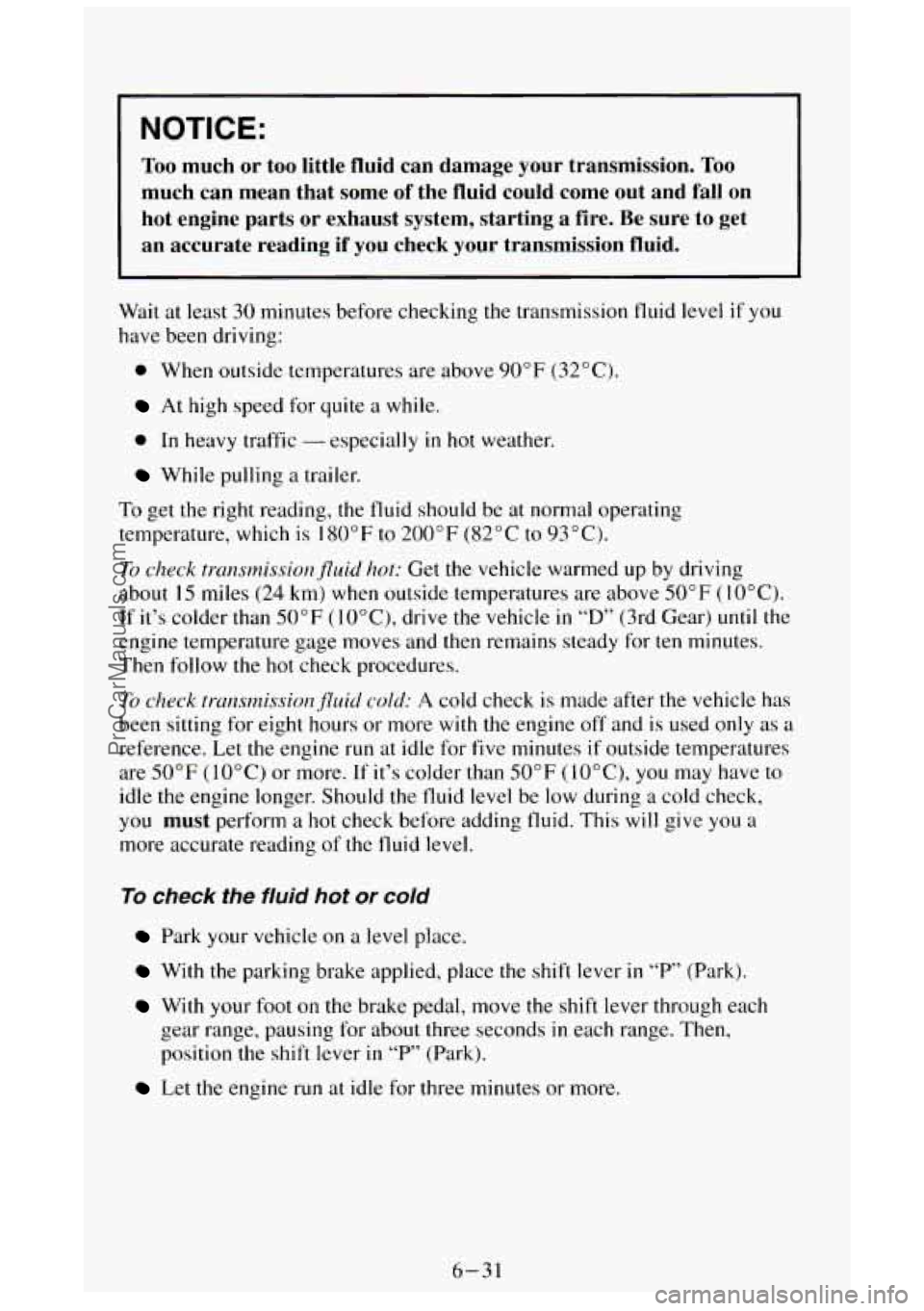
I NOTICE:
Too much or too little fluid can damage your transmission. Too
much can mean that some of the fluid could come out and fall on
hot engine parts or exhaust system, starting
a fire. Be sure to get
an accurate reading
if you check your transmission fluid.
Wait at least 30 minutes before checking the transmission fluid level if you
have been driving:
0 When outside temperatures are above 90°F (32°C).
At high speed for quite a while.
0 In heavy traffic - especially in hot weather.
While pulling a trailer.
IU get the right reading, the fluid should be at normal operating
temperature, which
is 180°F to 200°F (82°C to 93°C).
To check trunsmissioltfluid hot: Get the vehicle warmed up by driving
about
15 miles (24 km) when outside temperatures are above 50°F (1 0°C).
If it’s colder than
50°F (lO”C), drive the vehicle in “D” (3rd Gear) until the
engine temperature gage moves and then remains steady for ten minutes.
Then follow
the hot check procedures.
To check trmzsnzissiorz jZuid cold: A cold check is made after the vehicle has
been sitting for eight hours
or more with the engine off and is used only as a
reference. Let
the engine run at idle for five minutes if outside temperatures
are
50°F ( 10°C) or more. If it’s colder than 50°F (lO”C), you may have to
idle the engine longer. Should the fluid level be low during a cold check,
you must perform a hot check before adding fluid. This will give you a
more accurate reading of the fluid level.
To check the fluid hot or cold
Park your vehicle on a level place.
With the parking brake applied, place the shift lever in “P” (Park).
With your foot on the brake pedal, move the shift lever through each
gear range, pausing for about three seconds
in each range. Then,
position
the shift lever in “P’ (Park).
Let the engine run at idle for three minutes or more.
6-31
ProCarManuals.com
Page 282 of 404
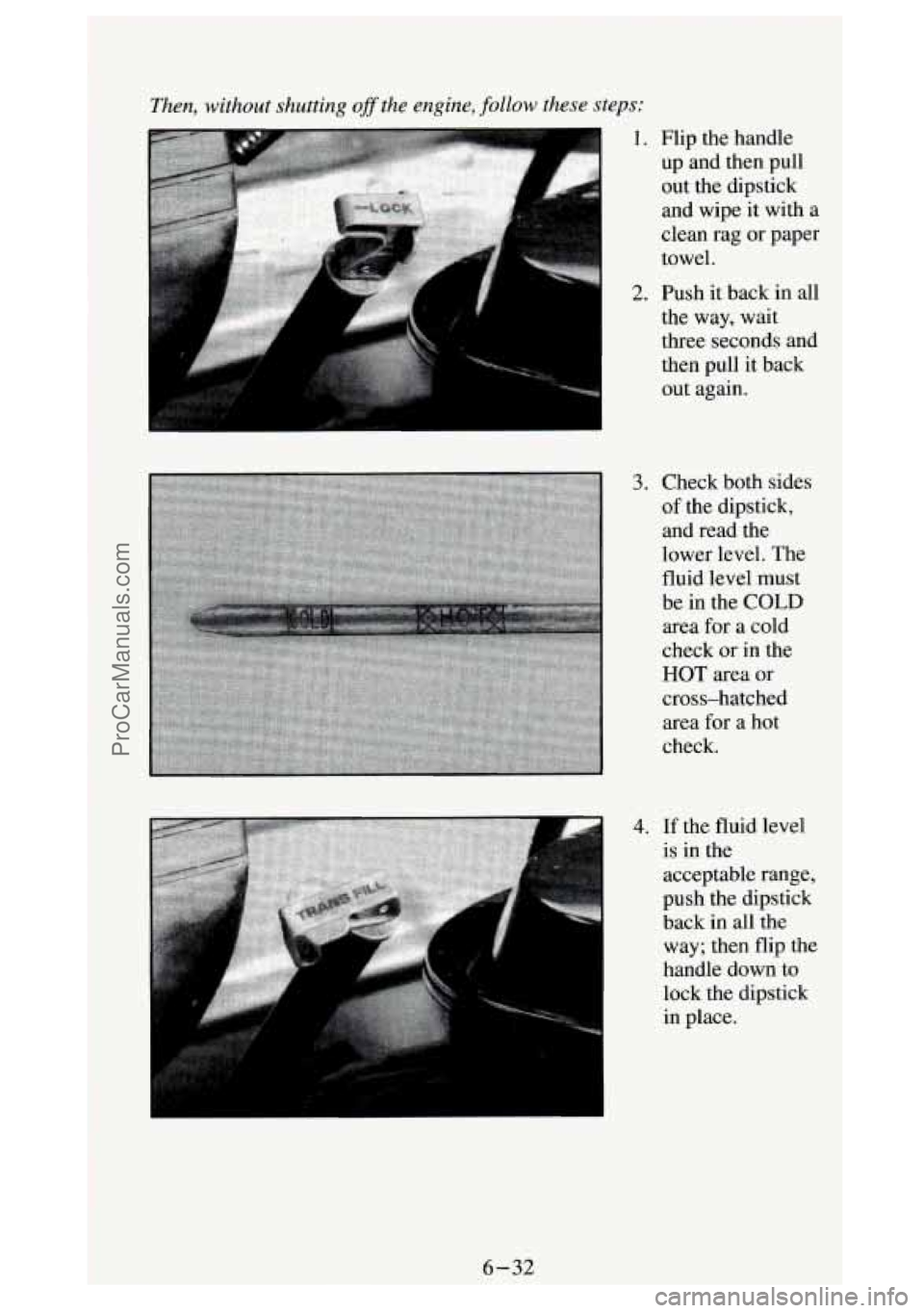
Then, .without shutting ofithe engine, follow these steps:
1. Flip the handle
up and then pull
out the dipstick
and wipe it with a
clean rag
or paper
towel.
2. Push it back in all
the way, wait
three seconds and
then pull it back
out again.
3. Check both sides
of the dipstick,
and read the
lower level. The
fluid level must
be in the COLD area for a cold
check or in the
HOT area or
cross-hatched
area for a hot
check.
4. If the fluid level
is in the
acceptable range,
push the dipstick back in all the
way; then flip the
handle down to
lock the dipstick in place.
ProCarManuals.com
Page 283 of 404
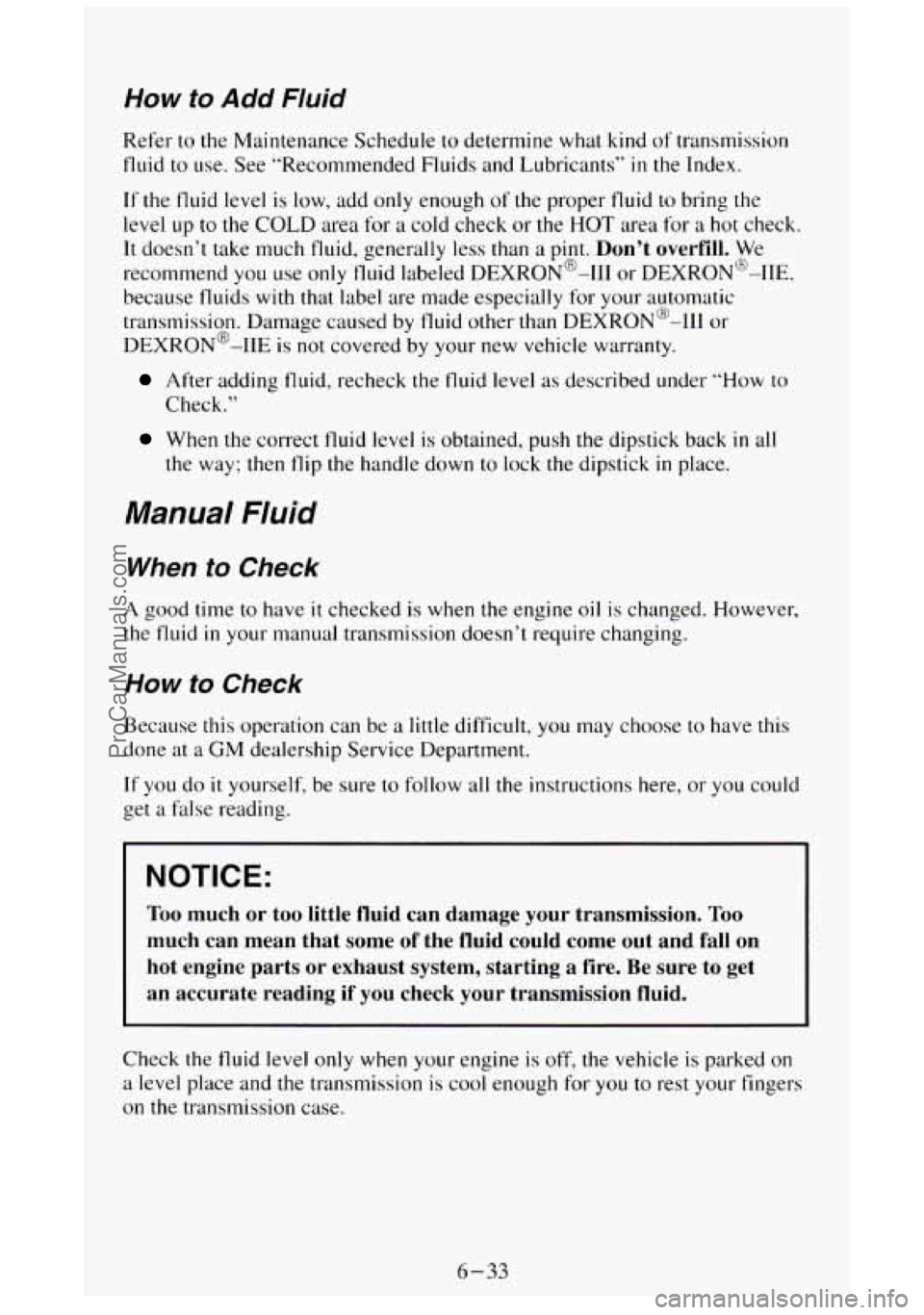
How to Add Fluid
Refer to the Maintenance Schedule to determine what kind of transmission
fluid
to use. See “Recommended Fluids and Lubricants” in the Index.
If the fluid level is low, add
only enough of the proper fluid to bring the
level up to the COLD area for a cold check or the HOT area for a hot check.
It doesn’t take much tluid, generally less than a pint. Don’t overfill. We
recommend you use only fluid labeled DEXRON@-111 or DEXRON@-IIE,
because fluids with that label are made especially for your automatic
transmission. Damage caused by fluid other than
DEXRON@-Ill or
DEXRON@-IIE is not covered by your new vehicle warranty.
After adding fluid, recheck the fluid level as described under “How to
Check.”
When the correct fluid level is obtained, push the dipstick back in all
the way; then flip the handle down to lock the dipstick in place.
Manual Fluid
When to Check
A good time to have it checked is when the engine oil is changed. However,
the fluid
in your manual transmission doesn’t require changing.
How to Check
Because this operation can be a little difficult, you may choose to have this
done at a
GM dealership Service Department.
If you do it yourself, be sure to follow all the instructions here, or you could
get
a false reading.
NOTICE:
Too much or too little fluid can damage your transmission. Too
much can mean that some of the fluid could come out and fall on
hot engine parts or exhaust system, starting a fire. Be sure to get
an accurate reading if
you check your transmission fluid.
Check the fluid level only when your engine is off, the vehicle is parked on
a level place and the transmission is cool enough for you to rest your fingers
on the transmission case.
6-33
ProCarManuals.com
Page 284 of 404
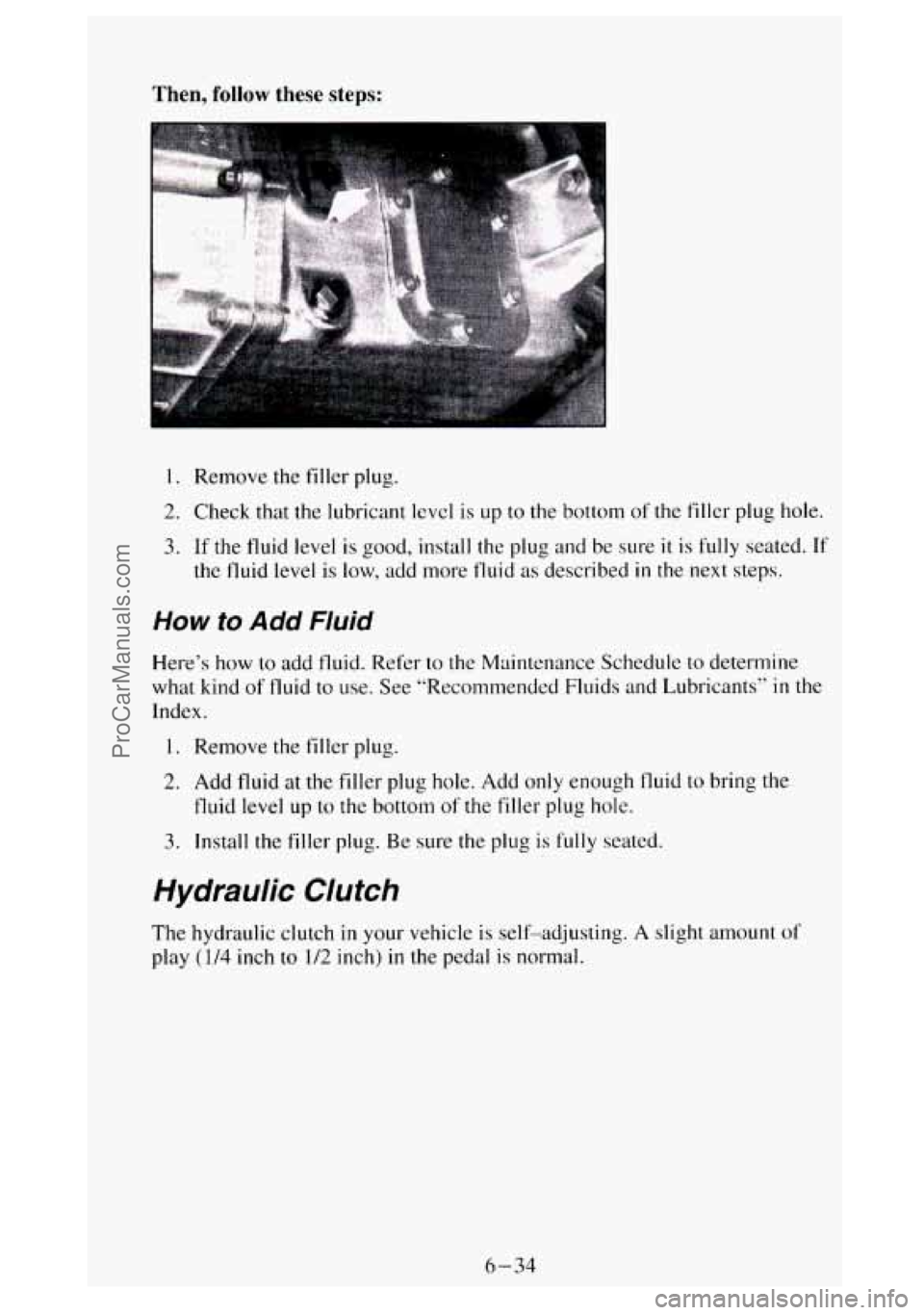
Then, follow these steps:
I. Remove the filler plug.
2. Check that the lubricant level is up to the bottom of the filler plug hole.
3. If the fluid level is good, install the plug and be sure it is fully seated. If
the fluid level is low, add more fluid as described in the next steps.
How to Add fluid
Here’s how to add fluid. Refer to the Maintenance Schedule to determine
what kind
of fluid to use. See “Recommended Fluids and Lubricants” in the
Index.
I. Remove the filler plug.
2. Add fluid at the filler plug hole. Add only enough fluid to bring the
fluid level up to
the bottom of the filler plug hole.
3. Install the filler plug. Be sure the plug is fully seated.
Hydraulic Clutch
The hydraulic clutch in your vehicle is self-adjusting. A slight amount of
play (1/4 inch to 1/2 inch) in the pedal is normal.
6-34
ProCarManuals.com
Page 285 of 404
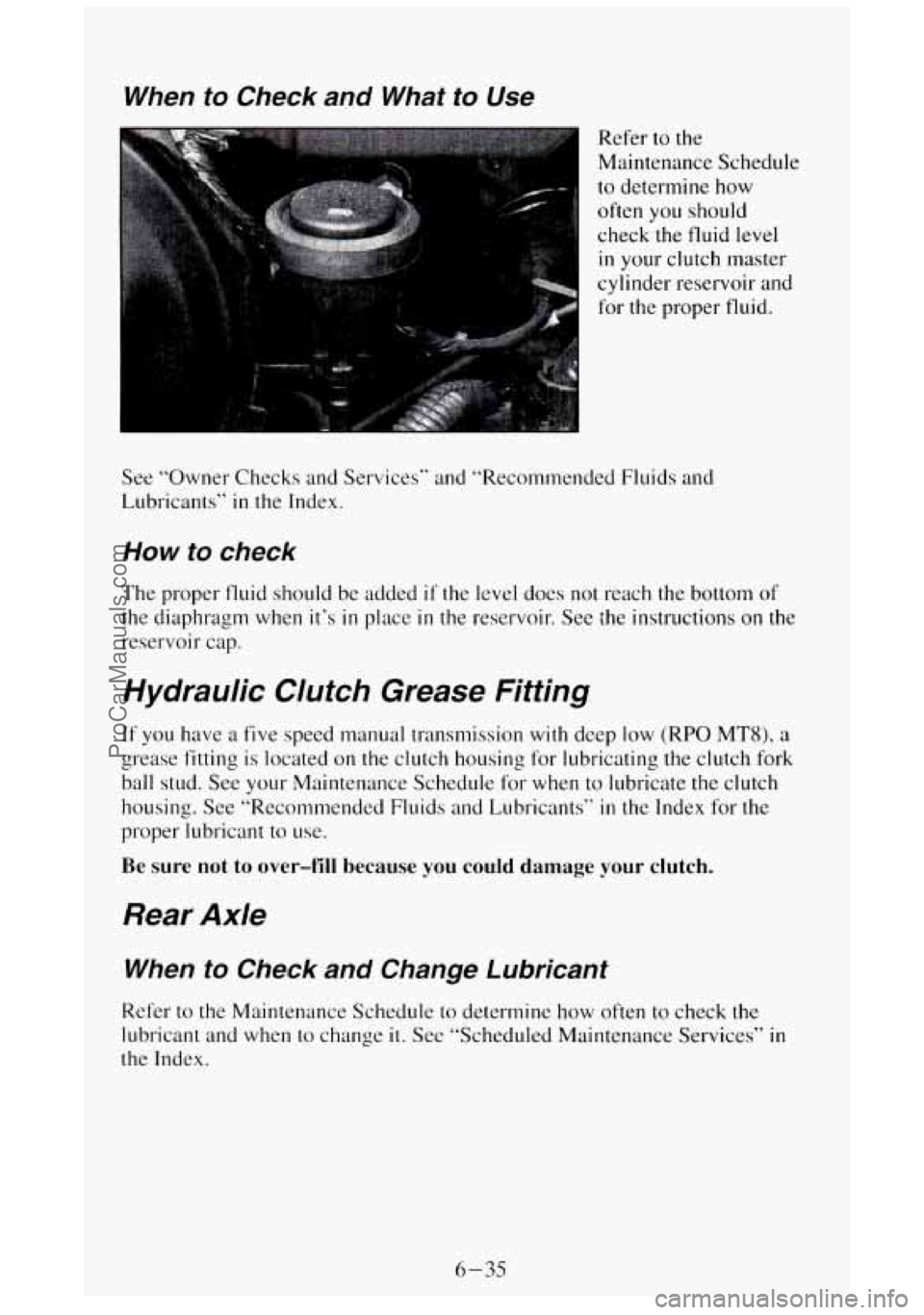
When to Check and What to Use
Refer to the
Maintenance Schedule
to determine how
often you should
check
the fluid level
in your clutch master
cylinder reservoir and
for the proper fluid.
See “Owner Checks and Services” and “Recommended Fluids and
Lubricants”
in the Index.
How to check
The proper fluid should be ridded if the level does not reach the bottom of
the diaphragm when it’s
in place in the reservoir. See the instructions on the
reservoir cap.
Hydraulic Clutch Grease Fitting
If you have a five speed manual transmission with deep low (RPO MT8), a
grease fitting is located on the clutch housing for lubricating the clutch fork
ball stud. See your Maintenance Schedule for when to lubricate the clutch
housing. See “Recommended Fluids and Lubricants”
in the Index for the
proper lubricant to
use.
Be sure not to over-fill because you could damage your clutch.
Rear Axle
When to Check and Change Lubricant
Refer to the Maintenance Schedule to determine how often to check the
lubricant and when to change
it. See “Scheduled Maintenance Services” in
the Index.
6-35
ProCarManuals.com
Page 286 of 404
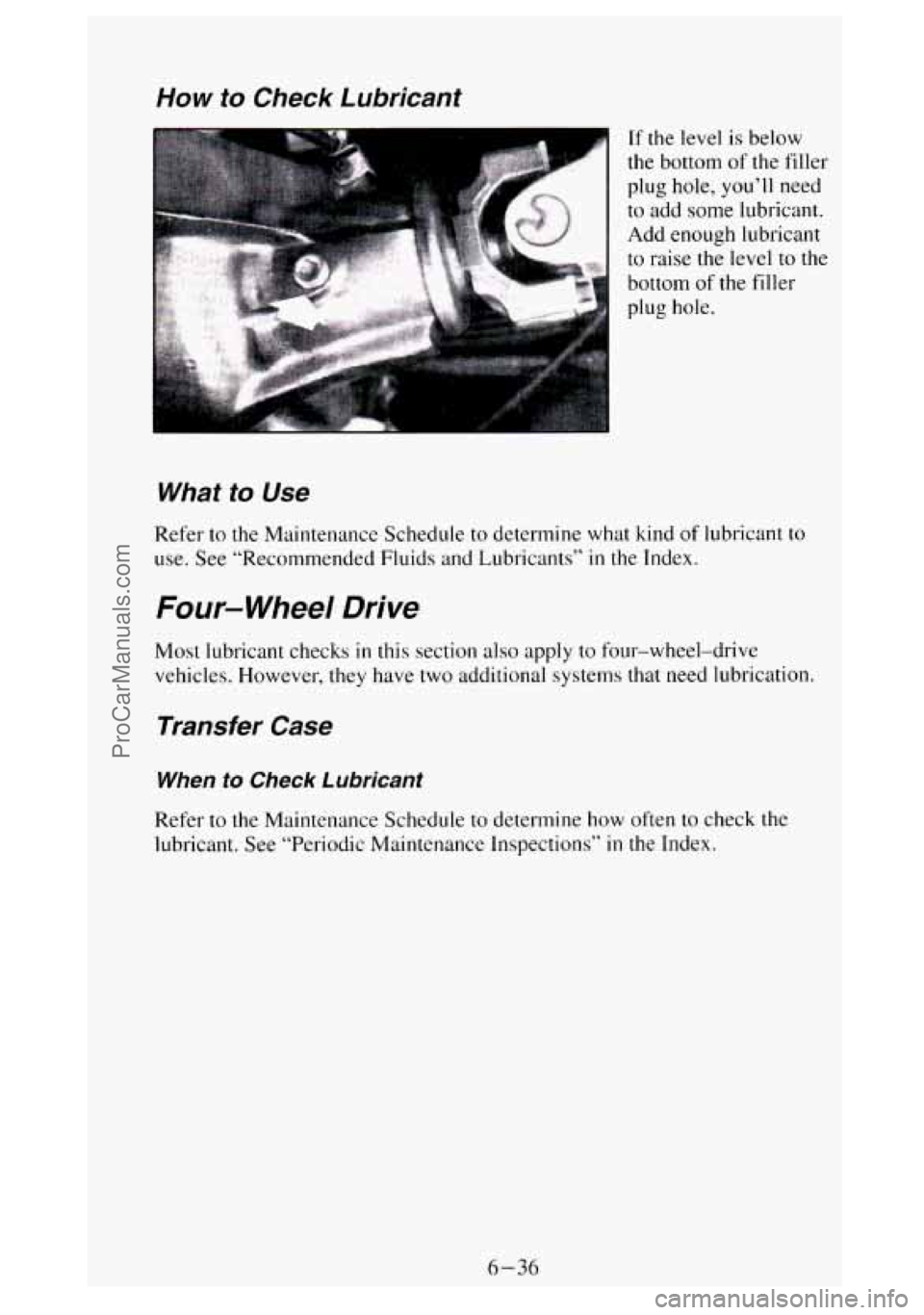
How to Check Lubricant
If the level is below
the bottom
of the filler
plug hole, you’ll need
to add some lubricant.
Add enough lubricant
to raise the level
to the
bottom of the filler
plug hole.
What to Use
Refer to the Maintenance Schedule to determine what kind of lubricant to
use. See “Recommended Fluids and Lubricants” in the Index.
Four- Wheel Drive
Most lubricant checks in this section also apply to four-wheel-drive
vehicles. However, they have two additional systems that need lubrication.
Transfer Case
When to Check Lubricant
Refer to the Maintenance Schedule to determine how often to check the
lubricant. See “Periodic Maintenance Inspections”
in the Index.
6-36
ProCarManuals.com
Page 287 of 404
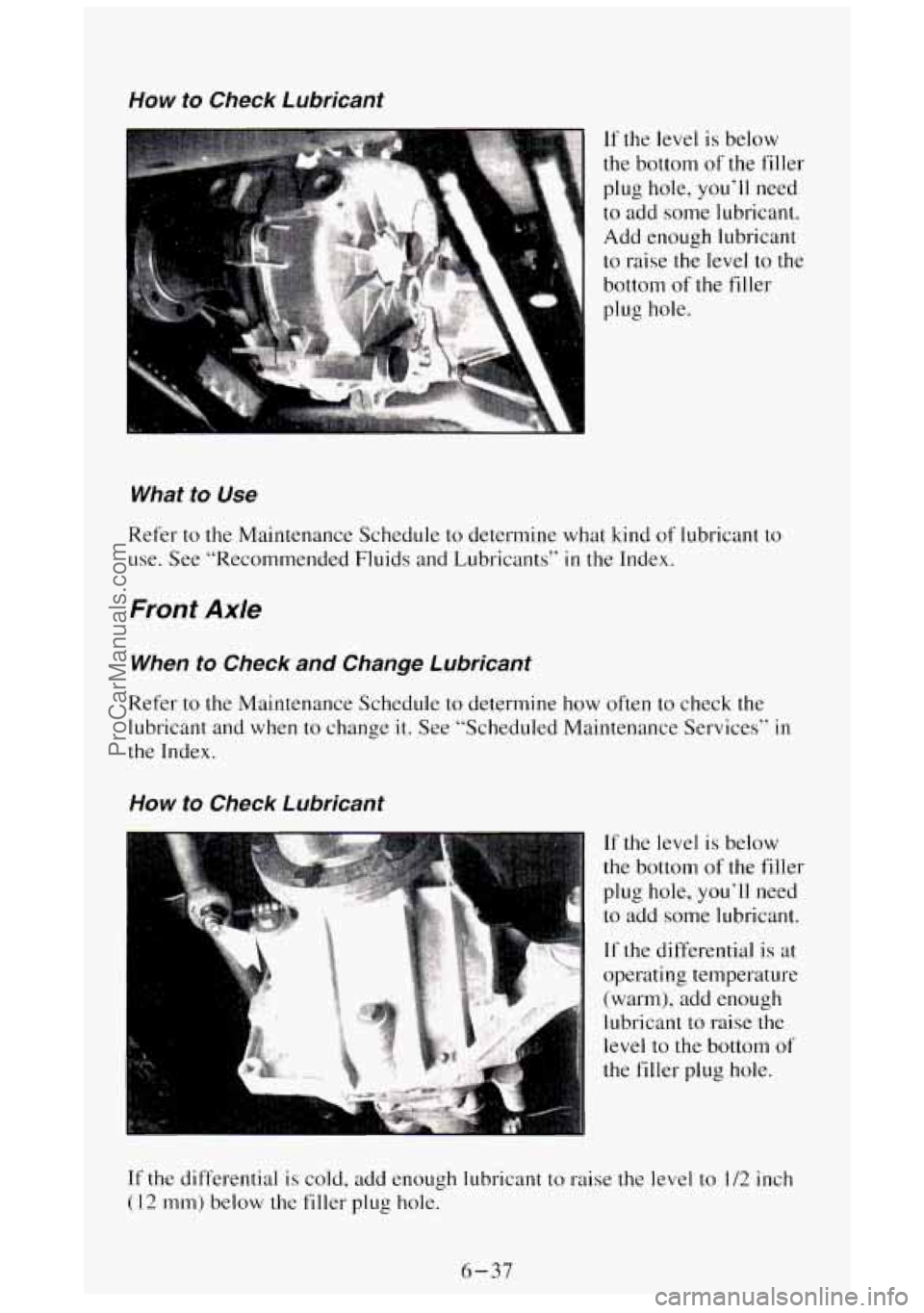
How to Check Lubricant
What to Use
- If the level is below
the
bottom of the filler
plug hole,
you’ll need
to add some lubricant.
Add enough lubricant
to raise the level to the
bottom of
the filler
plug hole.
Refer to the Maintenance Schedule to determine what kind
of lubricant to
use. See “Recommended Fluids and Lubricants” in the Index.
Front Axle
When to Check and Change Lubricant
Refer to the Maintenance Schedule to determine how often to check the
lubricant and when
to change it. See “Scheduled Maintenance Services” in
the Index.
How to Check Lubricant
If the level is below
the bottom of the filler
plug hole, you’ll need
to add some lubricant.
If the differential is at
operating temperature
(warm), add enough
lubricant
to raise the
level
to the bottom of
the filler plug hole.
If the differential is cold, add enough lubricant to raise the level to 1/2 inch
( 12 mm) below the filler plug hole.
6-37
ProCarManuals.com
Page 288 of 404
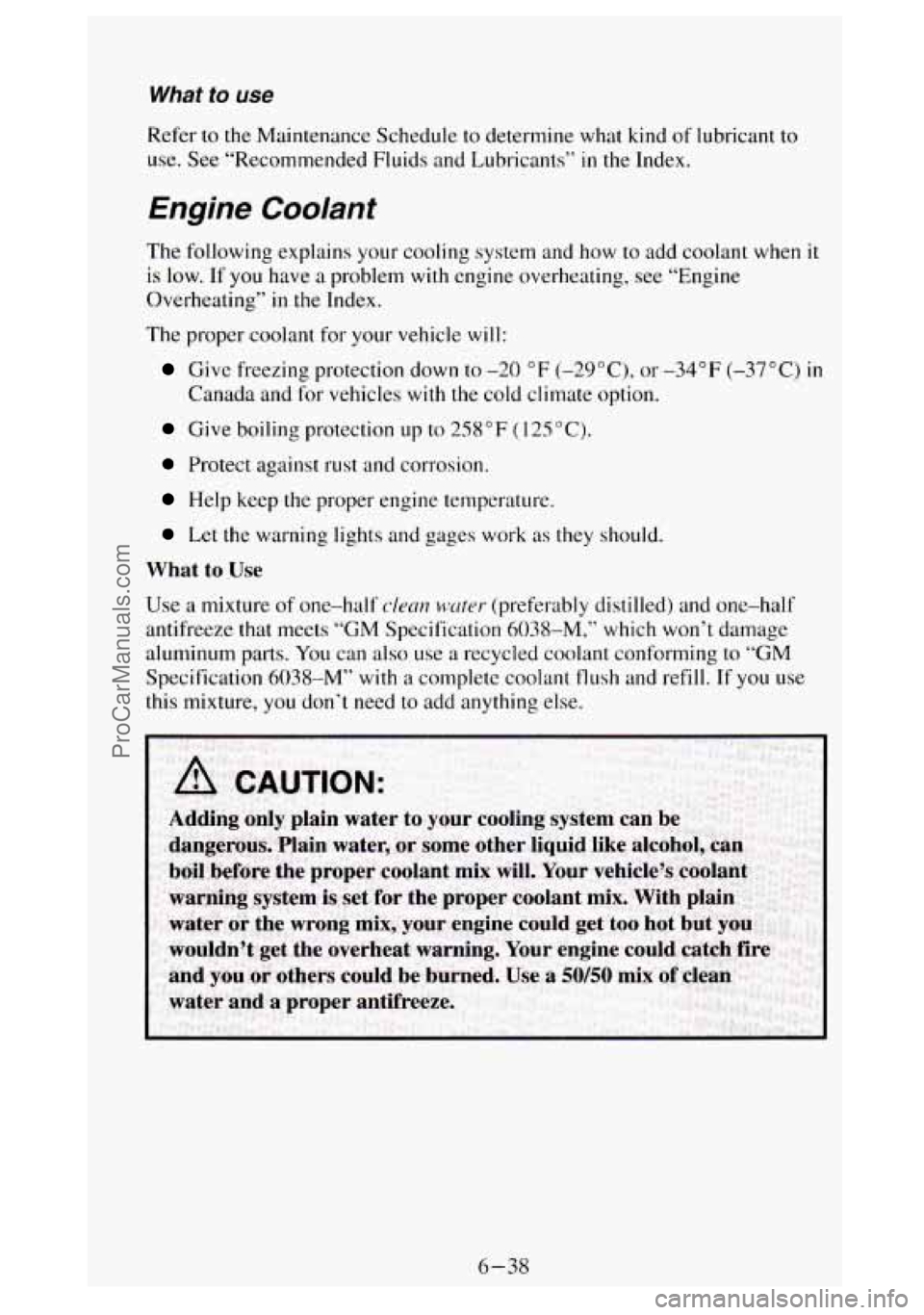
What to use
Refer to the Maintenance Schedule to determine what kind of lubricant to
use. See “Recommended Fluids and Lubricants”
in the Index.
Engine Coolant
The following explains your cooling system and how to add coolant when it
is low. If you have a problem with engine overheating, see “Engine
Overheating”
in the Index.
The proper coolant for your vehicle
will:
Give freezing protection down to -20 OF (-29”C), or -34°F (-37°C) in
Canada and for vehicles with the cold climate option.
Give boiling protection up to 258 OF ( 125 O C).
Protect against rust and corrosion.
Help keep the proper engine temperature.
Let the warning lights and gages work as they should.
What to Use
Use a mixture of one-half clean wuter (preferably distilled) and one-half
antifreeze that meets
“GM Specification 6038-M,” which won’t damage
aluminum parts.
You can also use a recycled coolant conforming to “GM
Specification 6038-M” with a complete coolant flush and refill. If you use
this mixture, you don’t need to add anything else.
6-38
ProCarManuals.com
Page 289 of 404
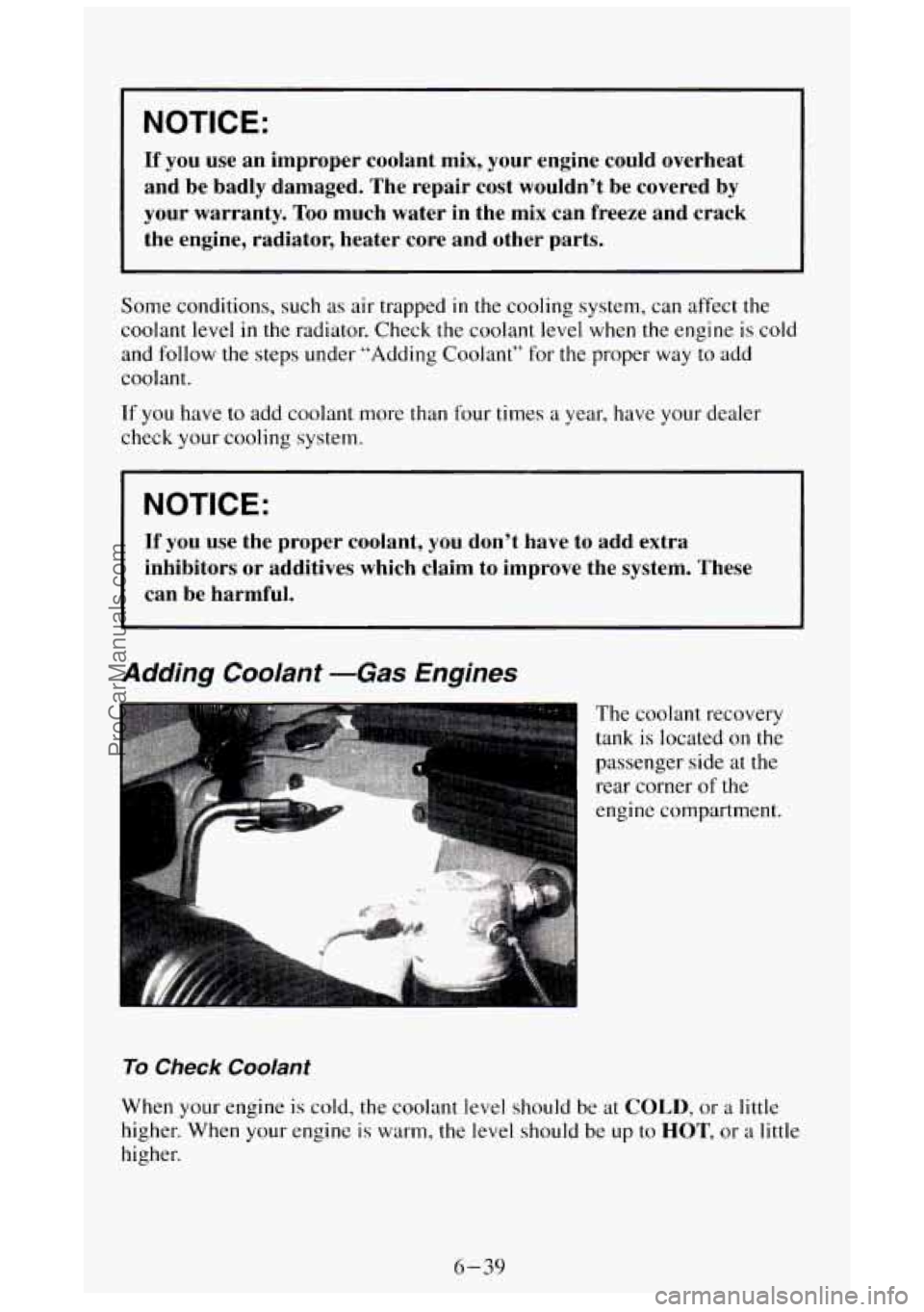
I NOTICE:
If you use an improper coolant mix, your engine could overheat
and be badly damaged.
The repair cost wouldn’t be covered by
your warranty.
Too much water in the mix can freeze and crack
the engine, radiator, heater core and other parts.
Some conditions, such as air trapped in the cooling system, can affect the
coolant level
in the radiator. Check the coolant level when the engine is cold
and follow the steps under “Adding Coolant” for the proper way to add
coolant.
If you have to add coolant more than four times a year, have your dealer
check your cooling system.
If you use the proper coolant, you don’t have to add extra
inhibitors or additives which claim to improve the system. These
can be harmful.
Adding Coolant -Gas Engines
To Check Coolant
The coolant recovery
tank
is located on the
passenger side at the
rear corner
of the
engine compartment.
When your engine
is cold, the coolant level should be at COLD, or a little
higher. When
your engine is warm, the level should be up to HOT, or a little
higher.
6-39
ProCarManuals.com
Page 290 of 404
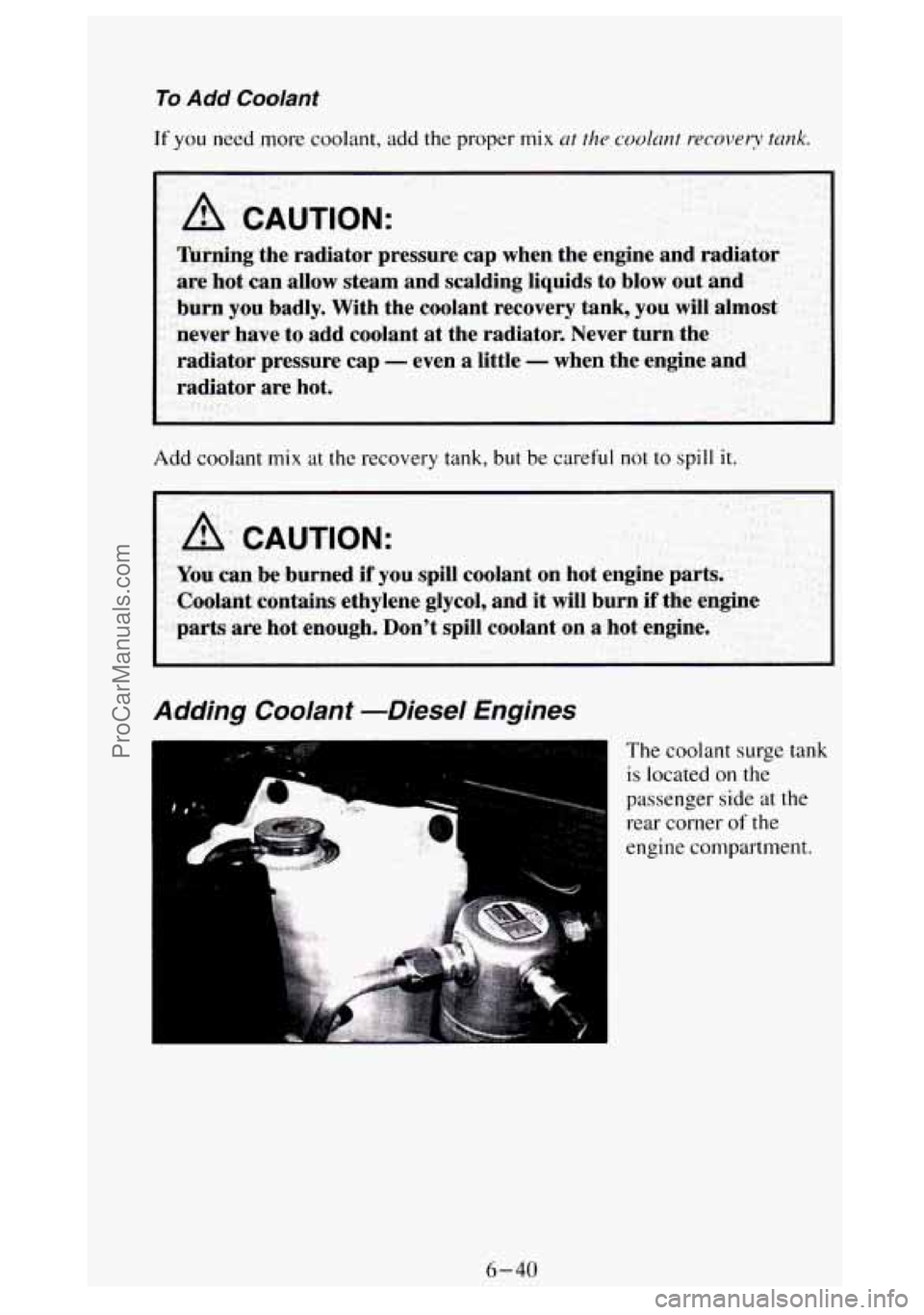
To Add Coolant
If you need more coolant, add the proper mix at the coolant recovery tunk.
A CAUTION:
Turning the radiator pressure cap when the engine and radiator
are hot can allow steam and scalding liquids to blow out and
burn you badly. With the coolant recovery tank, you will almost
never have to add coolant at the radiator. Never turn the
radiator pressure cap
- even a little - when the engine and
radiator are hot.
Add coolant mix at the recovery tank, but be careful not to spill it.
A CAUTION:
You can be burned if you spill coolant on hot engine parts.
Coolant contains ethylene glycol, and it will burn
if the engine
parts are hot enough. Don’t spill coolant on a hot engine.
Adding Coolant -Diesel Engines
The coolant surge tank
is located on the
passenger side at the
rear corner
of the
engine compartment.
6-40
ProCarManuals.com